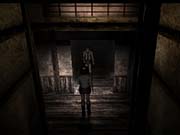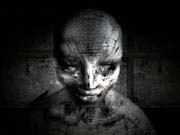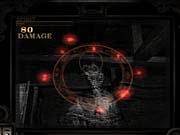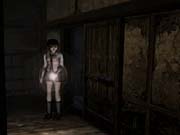Fatal Frame Preview
We take a look at Tecmo's upcoming survival-horror game.

Fatal Frame--known as Project Zero in Japan--is the latest product from Tecmo's Deception team. Apparently, the team has been at work on this one for quite a while, which is pretty evident judging from the code we've been playing--the game is visually and aurally very tight, and its game mechanics are very well thought out and engaging. It's still a survival-horror game at its core, but its discrete elements do much to liven the experience for those tired of that formula.
The game's story revolves around a young girl's quest to find her missing brother, who disappeared when searching for his literary idol. He managed to track him down at an abandoned mansion in a remote rural region, but he indeed found more than he'd bargained for. The mansion was haunted, as you'd expect, and, as you learn through the game's introductory sequence--which actually lets you play as the missing brother--the poor young man falls victim to some unknown, yet undoubtedly frightful, forces. When the game begins in earnest, you find yourself in the role of Miku Hinasaki, the missing young man's younger sister. She's decided to brave the mysteries of the mansion to find her missing brother, and she proceeds to venture forth unarmed. However, she soon finds a weapon quite capable of dispatching any hostile spirits that might lie within.

Fatal Frame's hook, as it were, is the weapon that you'll primarily use as you explore the haunted mansion--a plain-old camera. It has a couple of essential functions, but it serves primarily as a weapon. When you capture a hostile spirit within its viewfinder, you can damage it by snapping shots. You can also locate hidden doors and the like by examining the environment through its viewfinder whenever you suspect you're in the vicinity of something hidden. There's an onscreen light that gradually brightens as you approach something hidden, so you'll likely know when to switch to your viewfinder and start scanning. Other sensory cues are present as well, including ghostly, panning sounds and subtle controller rumblings, all of which help nudge you in the right direction.
The actual layout is classic survival-horror, however. Though everything is rendered in real-time 3D, you're allowed to explore the world via a series of mostly fixed angles, with a few dynamic yet scripted perspectives thrown in as appropriate. If you've ever played a survival-horror game, you'll likely be quite accustomed to the way you interact with the world; if you see something suspicious or otherwise worthy of inspection, you simply walk up to it and press the X button. A short dialogue will then appear, which describes the object in question and provides commentary from your character--very much par for the course. As you explore the mansion, you'll also come across various documents that let you piece together the site's mad history, and all of these you can file for perusal later. Journal entries, madmen's scribblings, and newspaper clippings are all lying around waiting for you to find them, as well as things like audio tapes, which you can play back and listen to in the interface menu. All in all, it plays very much like its kin. Where it manages to break free of the survival horror category's constraints, though, is when things get hairy.

When playing Fatal Frame, you're going to spend a lot of time behind your viewfinder. Your camera is your primary means of defense, so you'll have to draw on its unique powers whenever you're assailed by the soul-hungry ghosts within the mysterious mansion. It acts just a like a gun would in any other survival-horror game--in places of ammo, though, you have film, which comes in various degrees of power. As you defeat ghosts, you'll gain experience, which lets you power up your camera in various categories (shutter speed, accuracy, and so on) and purchase special powers for it. These special powers do various things; the cheapest one pushes ghosts back whenever you score a hit, while the most expensive paralyzes them outright. Other, more special powers too are unlocked when you complete specific parts of the game.
The act of combat is easily where Fatal Frame is at its most interesting. When you encounter a hostile spirit, you can quickly shift to your camera view by hitting the circle button. Once there, you can position your viewfinder with the left stick while using the right stick to move about, much like you would in a console first-person shooter. As the ghosts that are attacking you float about, you have to carefully keep them in your viewfinder to let your camera "charge" an attack--the longer you hold them in view, the more damage your attack will ultimately deliver. There's a circle in the center of your viewfinder, and this is where you'll have to hold the position for the shot. Runes under this circle light up every couple of seconds, each one representing an incremental increase in the power of the shot. Once you're satisfied, you hit either the X or R1 button to take the shot and then watch the ghost recoil. Or, if you want to execute one of your special attacks, you hit the L1 button instead. Combat is a pretty frenetic act in Fatal Frame--you'll usually have to keep a good distance from the ghosts as you shoot them or else they'll close enough to strike. And, as you're damaged, it becomes increasingly more difficult to move, so if you get off to a bad start, it's often pretty hard to cope. Still, you can move around while in the viewfinder mode, so you'll likely get used to it after a few sessions of combat.

The game's slick presentation makes all this work wonderfully. In the introductory sequence, everything is rendered in grainy black and white to convey the sequence's "flashback" nature. Once in the game proper, things are rendered in dim colors, but the eerie feeling remains. The environments are cramped by both lack of light and lack of space, so you'll often find yourself crawling through some very large rooms. The aural presentation is subtly executed as well, with phantom voices, sourceless creaks, and other, unspeakable things phasing in and out of your sensory range at odd moments. The game seems to easily stand among the greats of the survival-horror subcategory in terms of presentation. And the cinematic cutscenes that frequently cut into the action are quite suitably produced--the mood they convey is quite disturbed, genuinely drawing you into the game's mad story.
Fatal Frame is due out very soon in the US, and the build we've been playing is actually 100 percent complete. From what we've seen, it definitely seems like a great entry into what many perceive as a pretty tired category. Stay tuned for our full review very soon.
Got a news tip or want to contact us directly? Email news@gamespot.com
Join the conversation